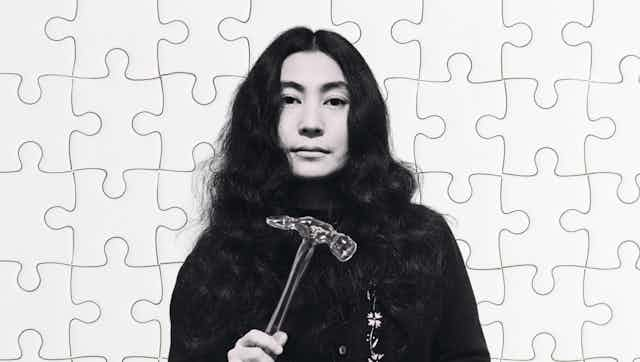Yoko Ono: Music of the Mind at the Tate Modern delves into the legacy of the Japanese artist and activist. It covers seven decades of Ono’s art, from the 1950s to the present day, and unfolds in a loosely chronological fashion. The show follows in her footsteps from the experimental music and avant-garde art circles in the US, Japan and the UK in the 1960s.
The exhibition draws its title from Ono’s Music of the Mind series of concerts and events held in London and Liverpool in 1966 and 1967. This makes explicit the crucial role music has played in her development as an artist and activist, and at once attaches and detaches her from the rock ‘n’ roll music context (and shadow) of her late husband, John Lennon.
Ono was a musician in her own right, having studied music composition throughout her life (as well as philosophy and poetry), whereas Lennon had studied art. Ono said on the meeting of their minds: “We crossed over into each other’s fields … from avant-garde leftfield to rock ’n’ roll leftfield. We tried to find a ground that was interesting to both of us. And we both got excited and stimulated by each other’s experiences.”
Ono’s ‘instructions’
In 1962, Ono hung 38 sheets of paper featuring a set of instructions, written in calligraphic Japanese script, on a wall of the Sogetsu Art Centre in Tokyo. No artist had exhibited concepts for artworks as artworks themselves before, so the show, Instructions for Paintings, was the first exhibition of conceptual art. Ono elevated art to an intensely intellectual activity, and the concept of art above its physical form.
Ono’s instructions also democratised art, as they triggered the imagination, thought and creativity of the audience who is left to “complete” the works by following the instructions in their real lives. This can be done by anyone, anywhere, at any time, either imaginatively or physically. One instruction entitled Painting To Be Constructed In Your Head reads: “Observe three paintings carefully. Mix them well in your head.”
Ono self-published her book, Grapefruit, a collection of over 200 instructions, in 1964. Many of them are scattered across the Tate galleries for visitors to follow.
The Tate show suggests that Ono’s work is a form of “participatory art”, a kind of art that engages audiences in the creative process. But this is reductive. Ono saw her instructions as encapsulations of ideas, and ideas as stones “thrown into the water for ripples to be made”.
I interpret Ono’s instructions as seeds for the cultivation of the “social imaginary” – an imaginary system of ideas, values, orientations and practices that binds society together. Beyond “creation”, Ono’s instruction project is a catalyst for continuous social change, a process of “construction” that leads to an alternative world.
Her instructions lead to a social balance between the individual and the collective, through reflective everyday acts. These small disruptive acts draw awareness to the fact that society is socially constructed, and so it is down to the power of people’s radical imaginary to change it.
Ono’s commitment to peace
For over seven decades, Ono’s radical ideas have contributed to powerful social ideas such as peace, freedom, equality and democracy. Her persistent commitment to world peace is expressed through her conception of art as a radical imaginary act.
Ono’s instructions are “meant for others to do”. But precisely what kind of “doing” do they enable? Works such as Shadow Piece – “Put your shadows together until they become one” – and Film No. 4 (Bottoms) – “String bottoms together in place of signatures for petition of peace” – instruct people to play, but to play “with” rather than “against” each other.
Ono’s playful works undermine the systemic causes that drive society’s problems and trigger processes of social imagining.
How do you play an all-white chess set with an “opponent” (White Chess Set, 1966), get undressed under a bag (Bag Piece, 1964), or shake hands through a hole in a canvas (Painting to Shake Hands, 1961) with a “stranger”? This requires working in concert with the other and coming up with a new set of rules – initiating new social relations that lead to radically new modes of thought and action.
Engaging the social imagination can contribute to changing the drives and consciousness of individual people who could collectively change the world – by imagining it not as it is, but as it ought to be. In doing so, they can construct the world they dream of. As Ono puts it: “A dream you dream alone is only a dream. A dream you dream together is reality.”
Ono’s distinct approach to the empowering social role of art galvanises people in many directions. To discover new constructive principles for creating spaces for critical thinking and artistic experimentation. For knowledge creation and political resistance. And to imagine an alternative world – because to “imagine” is to embark on a process of construction.

Looking for something good? Cut through the noise with a carefully curated selection of the latest releases, live events and exhibitions, straight to your inbox every fortnight, on Fridays. Sign up here.

